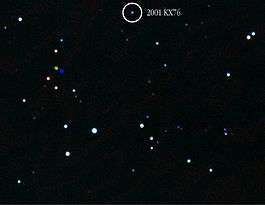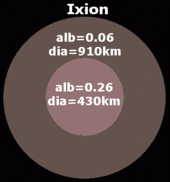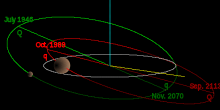28978 Ixion
 | |
| Discovery [1] | |
|---|---|
| Discovered by | Deep Ecliptic Srvy. |
| Discovery site | Cerro Tololo Obs. |
| Discovery date | 22 May 2001 |
| Designations | |
| MPC designation | (28978) Ixion |
| Pronunciation | /ɪkˈsaɪ.ən/ (ik-SY-ən)[lower-alpha 1] |
Named after |
Ixion (Greek mythology)[2] |
| 2001 KX76 | |
| TNO [1] · plutino[3][4] | |
| Adjectives | Ixionian |
| Orbital characteristics [1] | |
| Epoch 4 September 2017 (JD 2458000.5) | |
| Uncertainty parameter 3 | |
| Observation arc | 31.94 yr (11,665 days) |
| Earliest precovery date | 17 July 1982 |
| Aphelion | 49.256 AU |
| Perihelion | 30.071 AU |
| 39.664 AU | |
| Eccentricity | 0.2418 |
| 249.80 yr (91,240 days) | |
| 283.89° | |
| 0° 0m 14.04s / day | |
| Inclination | 19.587° |
| 70.996° | |
| 298.84° | |
| Physical characteristics | |
| Dimensions |
617+19 −20 km [5] 800.80 km[6] |
| 12.4±0.3 h[4] | |
| 0.141±0.011 [5] | |
|
B–V = 1.009±0.051[7] V–R = 0.610±0.030[7] V–I = 1.146±0.086[7] | |
| 19.84[8] | |
| 3.6[1] · 3.828±0.039[5] | |
|
| |
28978 Ixion (/ɪkˈsaɪ.ən/ ik-SY-ən), provisional designation 2001 KX76, is a plutino (an object that has a 2:3 orbital resonance with Neptune). It is very likely to be a dwarf planet,[9][10] although the IAU has not officially classified it as such. It was discovered on May 22, 2001 by the Cerro Tololo Inter-American Observatory.[11] It is named after Ixion, a figure from Greek mythology.[2]
Analysis of the lightcurve's brightness variation shows only small deviations, which suggests that Ixion is a spheroid with small albedo spots and hence a dwarf planet.[12] It has a diameter of approximately 650 km, making it about the fifth-largest plutino. It is moderately red in visible light and has a surface made of a mixture of tholin and water ice.
Physical characteristics

Other than Pluto, Ixion was the first trans-Neptunian object (TNO) discovered that was originally estimated to be larger than dwarf planet Ceres,[13] Even in 2002, a year after its discovery, Ixion was still believed to be more than 1000 km in diameter,[14] though the 2002 estimate was a result of a spurious detection at 250 GHz that was not confirmed by later observations.[15] More recent estimates suggest that Ixion has a high albedo[16] and is smaller than Ceres. Observations of Ixion by Herschel Space Telescope and Spitzer Space Telescope in the far-infrared part of the spectrum revealed that its size is about 620 km.[5]
Ixion is moderately red (slightly redder than 50000 Quaoar) in the visible light.[17] It also has a higher albedo (>0.15) than the mid-sized red cubewanos.[15] There may be an absorption feature at the wavelength of 0.8 μm in its spectrum, which is commonly attributed to the alteration of surface materials by water.[17] In the near-infrared the spectrum of Ixion is flat and featureless. Water ice absorption bands at 1.5 and 2 μm are absent. This is in contrast to Varuna, which has a red spectral slope in the near-infrared as well as prominent water absorption bands.[18] Both visible and infrared spectroscopic results indicate that Ixion's surface is a mixture of water ice, dark carbon and tholin, which is a heteropolymer formed by irradiation of clathrates of water and organic compounds.[19] The Very Large Telescope (VLT) has checked Ixion for cometary activity, but did not detect a coma.[20] Ixion is currently about 41 AU from the Sun,[8] and it is possible that Ixion could develop a coma or temporary atmosphere when it is closer to perihelion.
Orbit and rotation

Ixion and Pluto follow similar but differently oriented orbits: Ixion’s perihelion is below the ecliptic whereas Pluto's is above it. Uncharacteristically for bodies locked in resonance with Neptune (such as Orcus), Ixion approaches Pluto with less than 20 degrees of angular separation. Ixion is currently below the ecliptic and will reach its perihelion in 2070. Pluto has passed its perihelion (1989) and is descending toward the ecliptic. Ixion's orbital period is almost 250 Earth years, about 0.5% larger than Pluto's. Ixion does demonstrate some regular changes in brightness, which are thought to be caused by its rotation.[19]
In May 2010, a rotational lightcurve of Ixion was obtained from photometric observations by . Lightcurve analysis gave a rotation period of 12.4±0.3 hours with a small brightness variation confirming the body's supposed spheroidal shape (U=n.a.).[4][6]
Naming
This minor planet was named after Ixion, king of the Lapiths from Greek mythology. Ixion desired Zeus's wife, Hera. Zeus found out about his intentions and created the cloud Nephele in the shape of Hera, and tricked Ixion into coupling with it, fathering the race of Centaurs. For his crimes, Ixion was expelled from Olympus, blasted with a thunderbolt, and bound to a burning solar wheel in the underworld for all eternity.[2] The official naming citation was published on 28 March 2002 (M.P.C. 45236).[21]
Exploration
A study published in 2012 determined that Ixion and Huya were the most feasible out of seven possible TNO targets for an orbiter mission that would launch on an Atlas V 551 or Delta IV HLV and use a Jupiter flyby for a gravity assist.[22] A mission launched on 11 November 2039 would arrive at Ixion after 17 years cruise time.
See also
Notes
- ↑ Or as in Latin: Ixīōn, Ancient Greek: Ιξίων. Sometimes erroneously /ˈɪksiən/ IK-see-ən.
References
- 1 2 3 4 "JPL Small-Body Database Browser: 28978 Ixion (2001 KX76)" (2014-06-24 last obs.). Jet Propulsion Laboratory. Retrieved 16 June 2017.
- 1 2 3 Schmadel, Lutz D. (2007). Dictionary of Minor Planet Names – (28978) Ixion. Springer Berlin Heidelberg. p. 884. ISBN 978-3-540-00238-3. Retrieved 26 April 2017.
- ↑ M. W. Buie (12 July 2007). "Orbit Fit and Astrometric record for 28978". SwRI, Space Science Department. Retrieved 26 April 2017.
- 1 2 3 Galiazzo, M.; de la Fuente Marcos, C.; de la Fuente Marcos, R.; Carraro, G.; Maris, M.; Montalto, M. (July 2016). "Photometry of Centaurs and trans-Neptunian objects: 2060 Chiron (1977 UB), 10199 Chariklo (1997 CU26), 38628 Huya (2000 EB173), 28978 Ixion (2001 KX76), and 90482 Orcus (2004 DW)" (PDF). Astrophysics and Space Science. 361 (7): 15. arXiv:1605.08251. Bibcode:2016Ap&SS.361..212G. doi:10.1007/s10509-016-2801-5. Retrieved 26 April 2017.
- 1 2 3 4 Lellouch, E.; Santos-Sanz, P.; Lacerda, P.; Mommert, M.; Duffard, R.; Ortiz, J. L.; et al. (September 2013). ""TNOs are Cool": A survey of the trans-Neptunian region. IX. Thermal properties of Kuiper belt objects and Centaurs from combined Herschel and Spitzer observations" (PDF). Astronomy and Astrophysics. 557: 19. arXiv:1202.3657. Bibcode:2013A&A...557A..60L. doi:10.1051/0004-6361/201322047. Retrieved 26 April 2017.
- 1 2 "LCDB Data for (28978) Ixion". Asteroid Lightcurve Database (LCDB). Retrieved 26 April 2017.
- 1 2 3 Hainaut, O. R.; Boehnhardt, H.; Protopapa, S. (October 2012). "Colours of minor bodies in the outer solar system. II. A statistical analysis revisited". Astronomy and Astrophysics. 546: 20. arXiv:1209.1896. Bibcode:2012A&A...546A.115H. doi:10.1051/0004-6361/201219566. Retrieved 26 April 2017.
- 1 2 "AstDys (28978) Ixion Ephemerides". University of Pisa, Department of Mathematics. Retrieved 26 April 2017.
- ↑ Michael E. Brown. "How many dwarf planets are there in the outer solar system? (updates daily)". California Institute of Technology. Retrieved 26 April 2017.
- ↑ Tancredi, G. (2010). "Physical and dynamical characteristics of icy "dwarf planets" (plutoids)". Icy Bodies of the Solar System: Proceedings IAU Symposium No. 263, 2009 (PDF). Retrieved 26 April 2017.
- ↑ "28978 Ixion (2001 KX76)". Minor Planet Center. Retrieved 26 April 2017.
- ↑ Tancredi, G., & Favre, S. (2008) Which are the dwarfs in the Solar System?. Depto. Astronomía, Fac. Ciencias, Montevideo, Uruguay; Observatorio Astronómico Los Molinos, MEC, Uruguay. Retrieved 10-08-2011
- ↑ R. Stenger (24 August 2001). "New object deemed largest minor planet". CNN. Retrieved 26 April 2017.
- ↑ F. Bertoldi; W. Altenhoff; N. Junkes (7 October 2002). "Beyond Pluto: Max-Planck radioastronomers measure the sizes of distant minor planets". SpaceRef.com. Retrieved 26 April 2017.
- 1 2 Altenhoff, W. J.; Bertoldi, F.; Menten, K. M. (February 2004). "Size estimates of some optically bright KBOs". Astronomy and Astrophysics: 771–775. Bibcode:2004A&A...415..771A. doi:10.1051/0004-6361:20035603. Retrieved 26 April 2017.
- ↑ W. R. Johnston (5 September 2016). "TNO/Centaur diameters, albedos, and densities". Johnston's Archive. Retrieved 26 April 2017.
- 1 2 Marchi, S.; Lazzarin, M.; Magrin, S.; Barbieri, C. (September 2003). "Visible spectroscopy of the two largest known trans-Neptunian objects: Ixion and Quaoar". Astronomy and Astrophysics (3): L17–L19. Bibcode:2003A&A...408L..17M. doi:10.1051/0004-6361:20031142. Retrieved 26 April 2017.
- ↑ Licandro, J.; Ghinassi, F.; Testi, L. (June 2002). "Infrared spectroscopy of the largest known trans-Neptunian object 2001 KX75". Astronomy and Astrophysics: L9–L12. arXiv:astro-ph/0204104. Bibcode:2002A&A...388L...9L. doi:10.1051/0004-6361:20020533. Retrieved 26 April 2017.
- 1 2 Boehnhardt, H.; Bagnulo, S.; Muinonen, K.; Barucci, M. A.; Kolokolova, L.; Dotto, E.; et al. (February 2004). "Surface characterization of 28978 Ixion (2001 KX76)". Astronomy and Astrophysics: L21–L25. Bibcode:2004A&A...415L..21B. doi:10.1051/0004-6361:20040005. Retrieved 26 April 2017.
- ↑ Lorin, O.; Rousselot, P. (April 2007). "Search for cometary activity in three Centaurs (60558) Echeclus, 2000 FZ53 and 2000 GM137 and two trans-Neptunian objects [(29981) 1999 TD10 and (28978) Ixion]". Monthly Notices of the Royal Astronomical Society. 376 (2): 881–889. Bibcode:2007MNRAS.376..881L. doi:10.1111/j.1365-2966.2007.11487.x. Retrieved 26 April 2017.
- ↑ "MPC/MPO/MPS Archive". Minor Planet Center. Retrieved 26 April 2017.
- ↑ Gleaves, Ashley; Allen, Randall; Tupis, Adam; Quigley, John; Moon, Adam; Roe, Eric; Spencer, David; Youst, Nicholas; Lyne, James (2012-08-13). "A Survey of Mission Opportunities to Trans-Neptunian Objects - Part II, Orbital Capture". AIAA/AAS Astrodynamics Specialist Conference. Reston, Virigina: American Institute of Aeronautics and Astronautics. doi:10.2514/6.2012-5066. ISBN 9781624101823.
External links
- AstDys orbital elements
- 28978 Ixion at the JPL Small-Body Database
_(cropped).jpg)
